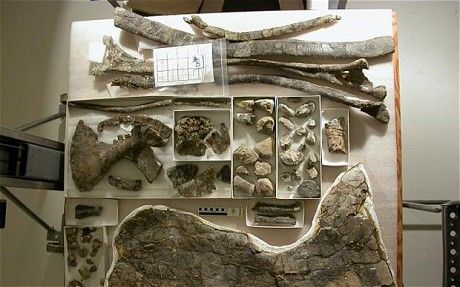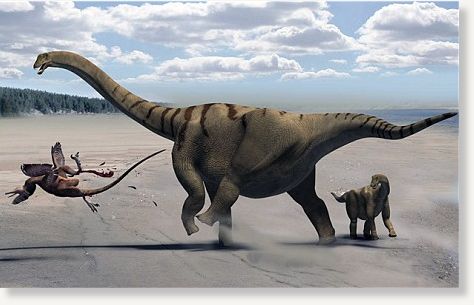Of all the work that palaeontologists do, perhaps nothing is as exciting as recognising and naming a new dinosaur.
I've now had the privilege of doing this twice - once in 2007, with Xenoposeidon, and now with Brontomerus. Both times, I've been the beneficiary of others' work: the Xenoposeidon fossil was found in 1893, but never properly studied until I happened across it in the basement of the Natural History Museum. Similarly, Brontomerus was excavated by the Oklahoma Museum of Natural History in 1994, but museum staff were too busy on other projects to give it the attention it deserved until I and some colleagues visited in 2007.
Staff in both museums were gracious in allowing an outsider to come in and work on their fossils.
The new dinosaur is particularly exciting because although only about 10 per cent of the skeleton is preserved, the bones hint at unusual and exotic behaviour.
The hip bone has a huge area for attachment of thigh muscles - more than twice that of most other sauropods, suggesting twice as much thigh muscle. This gave us the name for our new dinosaur: Brontomerus means "thunder thighs". But because the expanded part of the bone is towards the front of the animal, it presents us with a puzzle.
In a fast animal, we'd expect the muscles at the back of the thigh to be enlarged, so that the leg could be pulled back powerfully, but in Brontomerus, the large muscles are the ones that pull the leg forward.
Why would this be? One option is that the back-pulling muscles were also oversized - we can't tell for sure, because they would have attached to the base of the tail, and we don't have fossils from that part of the animal.

Only the discovery of more complete fossils can resolve this conclusively. But given the bones that we have, the most likely explanation for the front-of-thigh muscles is that they enabled Brontomerus to deliver a powerful kick. What would this have been used for?
Most likely it would have initially involved as a way for males to fight over females, much as male deer fight with their antlers, and giraffes by crashing their necks together.
In many animals, this kind of combat appears ritualistic: sometimes it's more of a dominance display than an actual fight.
But once the kick had evolved, it would also have surely been used in defence against predators - something very necessary for poor Brontomerus, which lived in the same and place as giant raptors and the T. rex-sized predator Acrocanthosaurus.
Evolution often works this way: a feature that evolves under one kind of pressure turns out to be useful in other ways. Just as the feathers of birds may have evolved first for insulation before allowing them to fly, so a feature that evolved to allow Brontomerus to show off to the girls might have saved its life on the plains of Utah, 100 million years ago.




Reader Comments
to our Newsletter